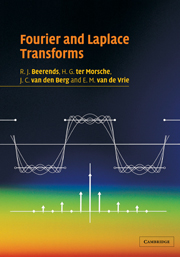Book contents
- Frontmatter
- Contents
- Preface
- Introduction
- Part 1 Applications and foundations
- Part 2 Fourier series
- Part 3 Fourier integrals and distributions
- 6 Fourier integrals: definition and properties
- 7 The fundamental theorem of the Fourier integral
- 8 Distributions
- 9 The Fourier transform of distributions
- 10 Applications of the Fourier integral
- Part 4 Laplace transforms
- Part 5 Discrete transforms
- Literature
- Tables of transforms and properties
- Index
8 - Distributions
Published online by Cambridge University Press: 05 June 2012
- Frontmatter
- Contents
- Preface
- Introduction
- Part 1 Applications and foundations
- Part 2 Fourier series
- Part 3 Fourier integrals and distributions
- 6 Fourier integrals: definition and properties
- 7 The fundamental theorem of the Fourier integral
- 8 Distributions
- 9 The Fourier transform of distributions
- 10 Applications of the Fourier integral
- Part 4 Laplace transforms
- Part 5 Discrete transforms
- Literature
- Tables of transforms and properties
- Index
Summary
INTRODUCTION
Many new concepts and theories in mathematics arise from the fact that one is confronted with problems that existing theories cannot solve. These problems may originate from mathematics itself, but often they arise elsewhere, such as in physics. Especially fundamental problems, sometimes remaining unsolved for years, decades or even centuries, have a very stimulating effect on the development of mathematics (and science in general). The Greeks, for example, tried to find a construction of a square having the same area as the unit circle. This problem is known as the ‘quadrature of the circle’ and remained unsolved for some two thousand years. Not until 1882 it was found that such a construction was impossible, and it was discovered that the area of the unit circle, hence the number π, was indeed a very special real number.
Many of the concepts which one day solved a very fundamental problem are now considered obvious. Even the concept of ‘function’ has one day been heavily debated, in particular relating to questions on the convergence of Fourier series. Problems arising in the context of the solutions of quadratic and cubic equations were solved by introducing the now so familiar complex numbers. As is well-known, the complex numbers form an extension of the set of real numbers.
In this chapter we will introduce new objects, the so-called ‘distributions’, which form an extension of the concept of function.
- Type
- Chapter
- Information
- Fourier and Laplace Transforms , pp. 188 - 207Publisher: Cambridge University PressPrint publication year: 2003



